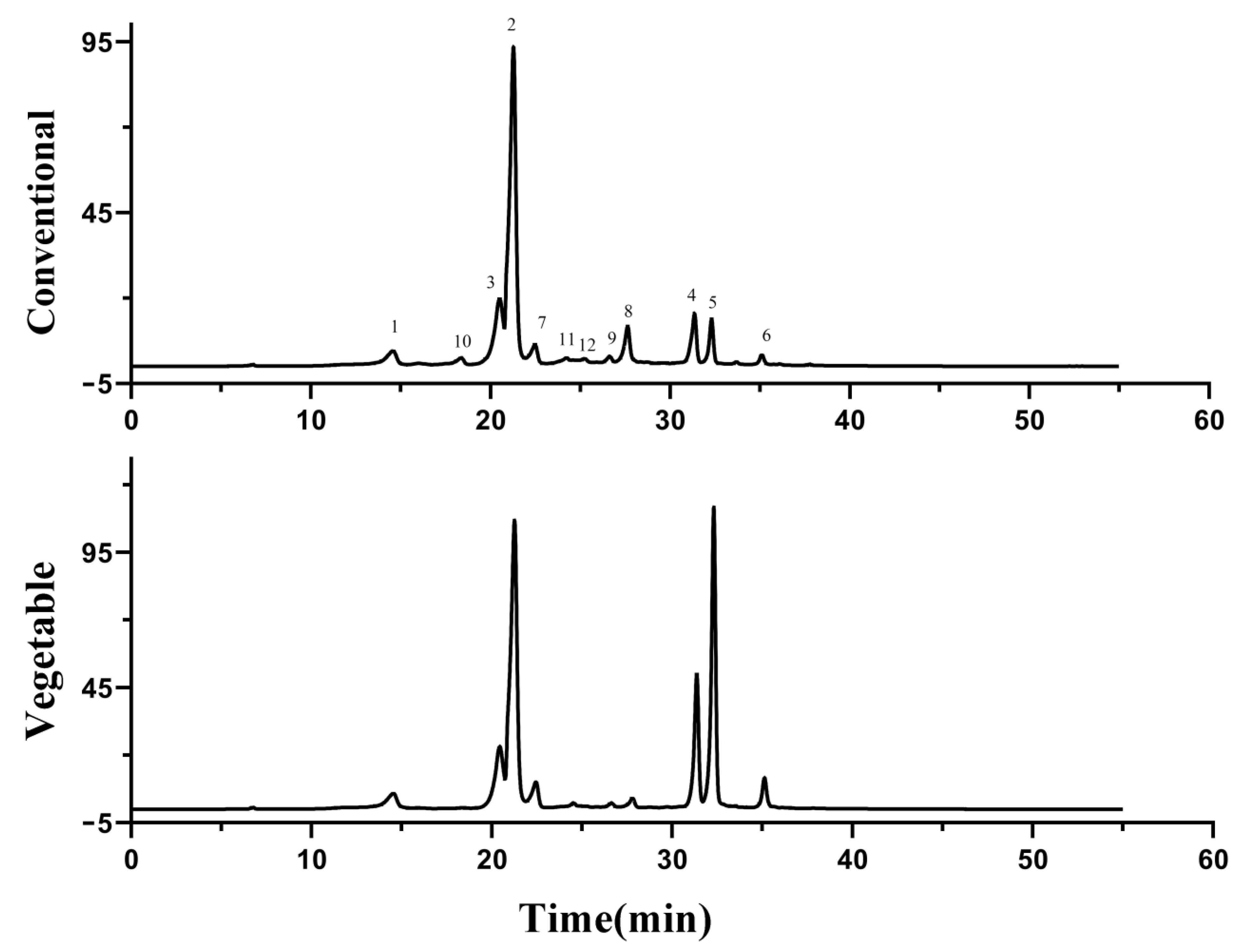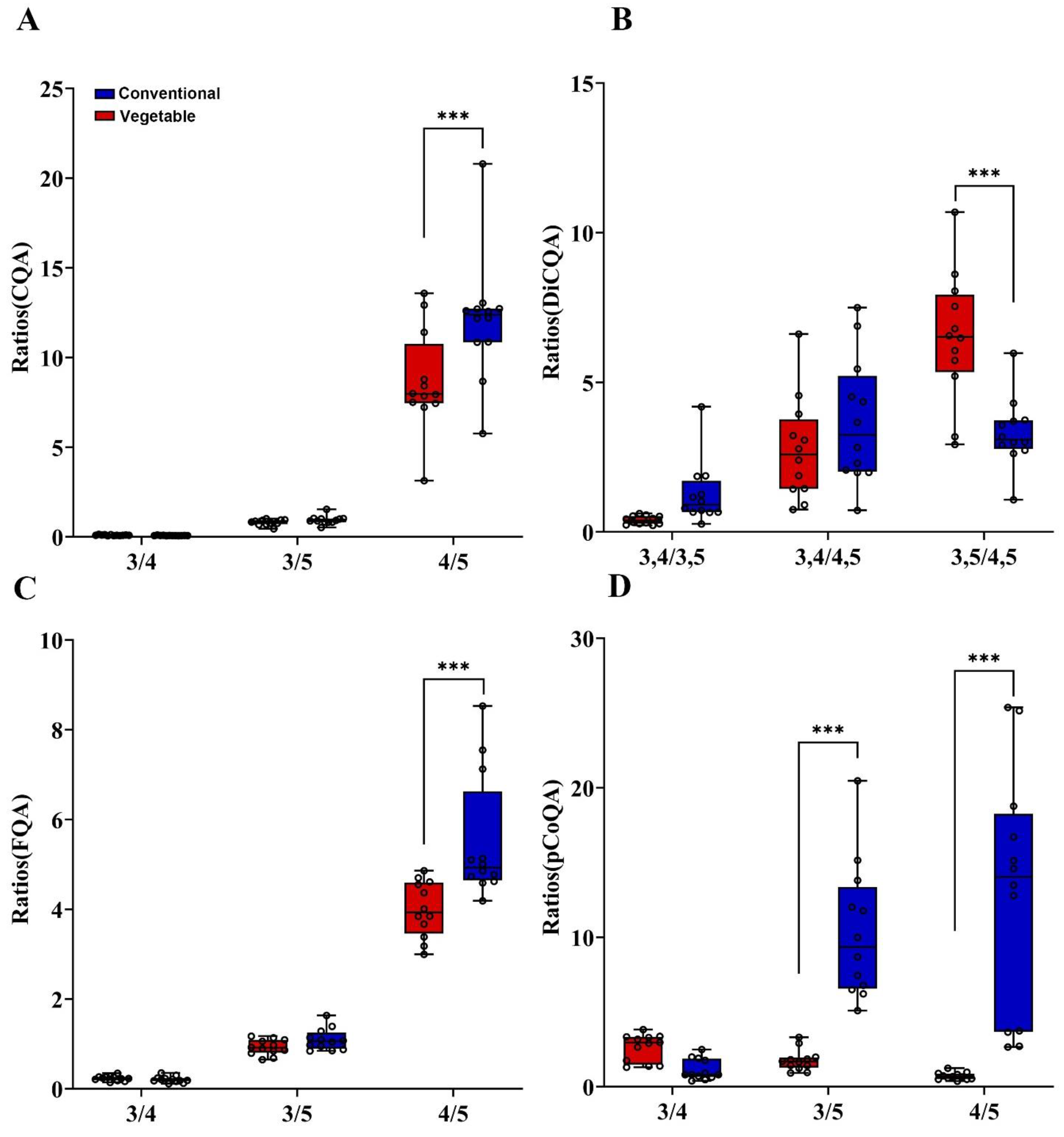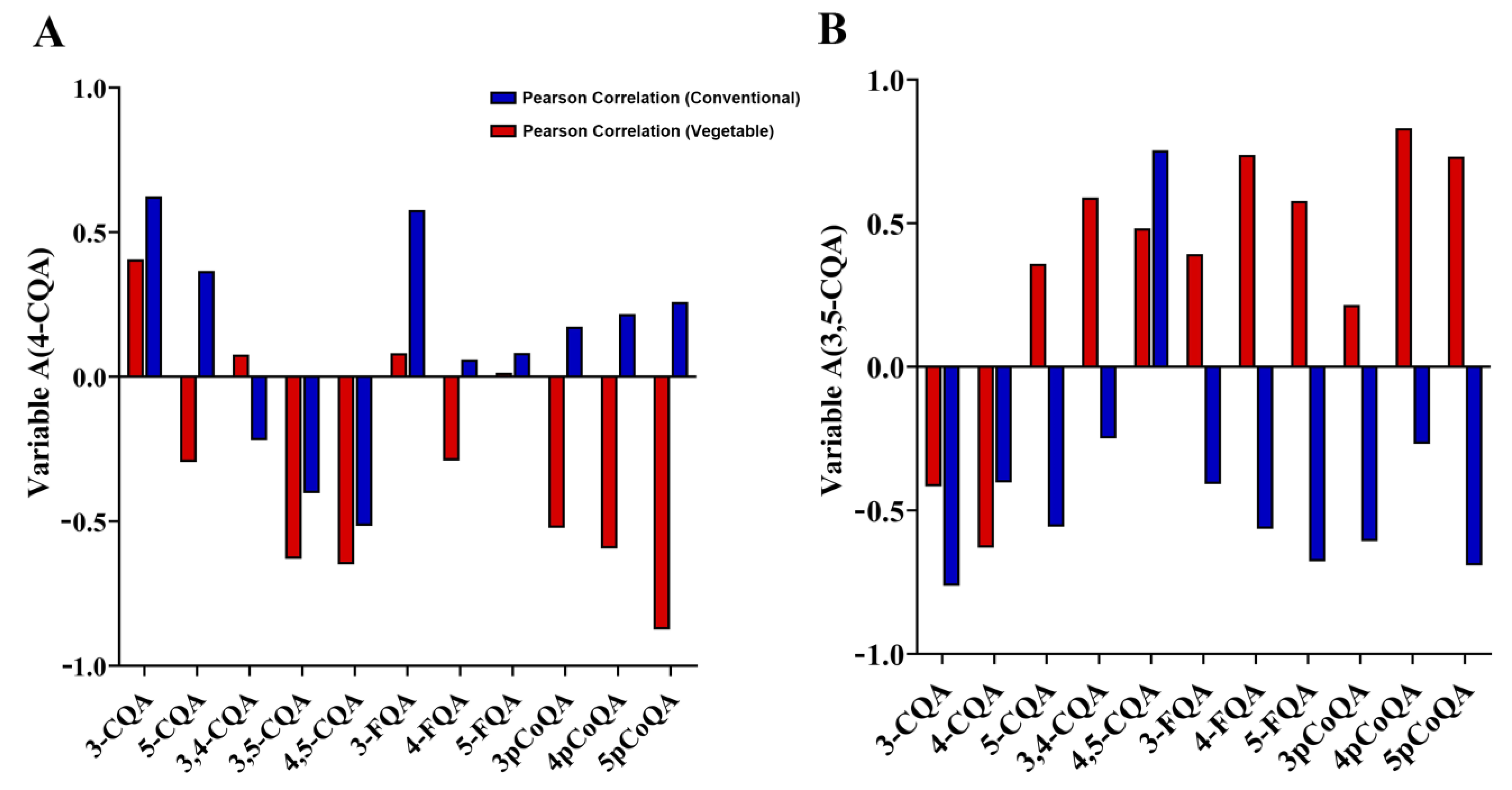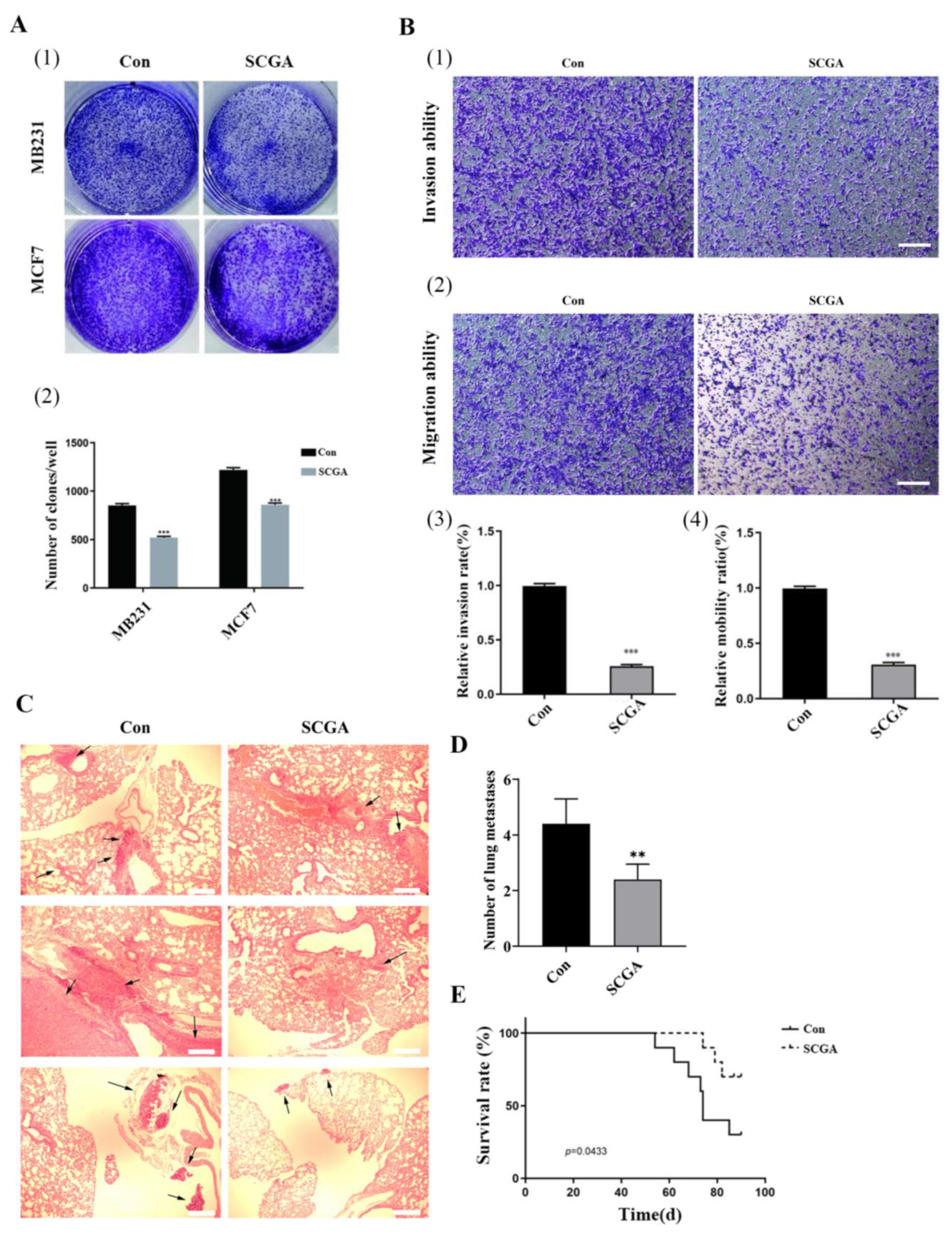Composition and Bioactivity of Chlorogenic Acids in Vegetable and Conventional Sweet Potato Vine Tips
Abstract
:1. Introduction
2. Materials and Methods
2.1. Sample Preparation
2.2. Optimization of Process Parameters for CGA Extraction from Sweet Potato Vine Tips
2.3. Flocculation Precipitation and Decolorization
2.4. CGA Content Assay
2.5. Purification of CGA Using NKA-9 Macroporous Adsorption Resin
2.6. Animals and Cell Experimental Protocol
2.6.1. Migration and Invasion Experiments
2.6.2. Mouse Model for Human Breast Cancer Lung Metastasis
2.7. High Resolution LC-MSn
2.8. Statistical Evaluation
3. Results and Discussion
3.1. CGA Extraction and Purification of Sweet Potato Vine Tips
3.2. Qualitative and Quantitative Analysis of CGA in Sweet Potato Vine Tips by LC-MS
3.2.1. Mono-Caffeoylquinic Acids (CQA) and di-Caffeoylquinic Acids (diCQA)
3.2.2. Feruloyl Quinic Acids (FQA), –p-Coumaroyl Quinic Acids (pCoQA)
3.3. Inspection of Characteristic Isomer Ratio Parameters by Comparing Vegetable and Conventional Samples CGA Quantitative Data
3.4. Statistical Analysis Using p-Values and Pearson Correlation Coefficient
3.5. Principal Component Analysis and Linear Discriminant Analysis Model
3.6. Purified Sweet Potato CGA (SCGA) Bioactivity Assay
4. Conclusions
Supplementary Materials
Author Contributions
Funding
Institutional Review Board Statement
Data Availability Statement
Acknowledgments
Conflicts of Interest
References
- Clifford, M.N.; Wu, W.; Kuhnert, N. The chlorogenic acids of Hemerocallis. Food Chem. 2006, 95, 574–578. [Google Scholar] [CrossRef]
- Marques, V.; Farah, A. Chlorogenic acids and related compounds in medicinal plants and infusions. Food Chem. 2009, 113, 1370–1376. [Google Scholar] [CrossRef]
- Tang, C.-C.; Ameen, A.; Fang, B.-P.; Liao, M.-H.; Chen, J.-Y.; Huang, L.-F.; Zou, H.-D.; Wang, Z.-Y. Nutritional composition and health benefits of leaf-vegetable sweet potato in South China. J. Food Compos. Anal. 2021, 96, 103714. [Google Scholar] [CrossRef]
- Clifford, M.N.; Jaganath, I.B.; Ludwig, I.A.; Crozier, A. Chlorogenic acids and the acyl-quinic acids: Discovery, biosynthesis, bioavailability and bioactivity. Nat. Prod. Rep. 2017, 34, 1391–1421. [Google Scholar] [CrossRef] [PubMed]
- Ky, C.-L.; Louarn, J.; Dussert, S.; Guyot, B.; Hamon, S.; Noirot, M. Caffeine, trigonelline, chlorogenic acids and sucrose diversity in wild Coffea arabica L. and C. canephora P. accessions. Food Chem. 2001, 75, 223–230. [Google Scholar] [CrossRef]
- Hansen, C.E.; Mañez, A.; Burri, C.; Bousbaine, A. Comparison of enzyme activities involved in flavour precursor formation in unfermented beans of different cocoa genotypes. J. Sci. Food Agric. 2000, 80, 1193–1198. [Google Scholar] [CrossRef]
- Jonfia-Essien, W.A.; West, G.; Alderson, P.G.; Tucker, G. Phenolic content and antioxidant capacity of hybrid variety cocoa beans. Food Chem. 2008, 108, 1155–1159. [Google Scholar] [CrossRef]
- Elwers, S.; Zambrano, A.; Rohsius, C.; Lieberei, R. Differences between the content of phenolic compounds in Criollo, Forastero and Trinitario cocoa seed (Theobroma cacao L.). Eur. Food Res. Technol. 2009, 229, 937–948. [Google Scholar] [CrossRef]
- Oracz, J.; Zyzelewicz, D.; Nebesny, E. The content of polyphenolic compounds in cocoa beans (Theobroma cacao L.), depending on variety, growing region, and processing operations: A review. Crit. Rev. Food Sci. Nutr. 2015, 55, 1176–1192. [Google Scholar] [CrossRef]
- Shan, J.; Suzuki, T.; Suhandy, D.; Ogawa, Y.; Kondo, N. Chlorogenic acid (CGA) determination in roasted coffee beans by Near Infrared (NIR) spectroscopy. Eng. Agric. Environ. Food 2014, 7, 139–142. [Google Scholar] [CrossRef]
- Morishita, H.; Iwahashi, H.; Osaka, N.; Kido, R. Chromatographic separation and identification of naturally occurring chlorogenic acids by 1H nuclear magnetic resonance spectroscopy and mass spectrometry. J. Chromatogr. A 1984, 315, 253–260. [Google Scholar] [CrossRef] [PubMed]
- Lu, H.; Tian, Z.; Cui, Y.; Liu, Z.; Ma, X. Chlorogenic acid: A comprehensive review of the dietary sources, processing effects, bioavailability, beneficial properties, mechanisms of action, and future directions. Compr. Rev. Food Sci. Food Saf. 2020, 19, 3130–3158. [Google Scholar] [CrossRef] [PubMed]
- D’Souza, R.N.; Grimbs, S.; Behrends, B.; Bernaert, H.; Ullrich, M.S.; Kuhnert, N. Origin-based polyphenolic fingerprinting of Theobroma cacao in unfermented and fermented beans. Food Res. Int. 2017, 99 Pt 1, 550–559. [Google Scholar] [CrossRef]
- Endrawati, H.; Widianingsih, W.; Nuraini, R.A.T.; Hartati, R.; Redjeki, S.; Riniatsih, I.; Mahendrajaya, R.T. The effect of chitosan concentration on flocculation efficiency microalgae Porphyridium cruentum (Rhodhophyta). IOP Conf. Ser. Earth Environ. Sci. 2021, 919, 012052. [Google Scholar] [CrossRef]
- Sessa, D.J.; Palmquist, D.E. Effect of heat on the adsorption capacity of an activated carbon for decolorizing/deodorizing yellow zein. Bioresour. Technol. 2008, 99, 6360–6364. [Google Scholar] [CrossRef]
- Kolade, M.A.; Kogelbauer, A.; Alpay, E. Adsorptive reactor technology for VOC abatement. Chem. Eng. Sci. 2009, 64, 1167–1177. [Google Scholar] [CrossRef]
- Yu, C.; Chiang, P.C.; Huang, C.P. Effects of pore structure and temperature on VOC adsorption on activated carbon. Carbon 2001, 39, 523–534. [Google Scholar]
- Cicco, N.; Lanorte, M.T.; Paraggio, M.; Viggiano, M.; Lattanzio, V. A reproducible, rapid and inexpensive Folin–Ciocalteu micro-method in determining phenolics of plant methanol extracts. Microchem. J. 2009, 91, 107–110. [Google Scholar] [CrossRef]
- Jaiswal, R.; Kuhnert, N. Hierarchical scheme for liquid chromatography/multi-stage spectrometric identification of 3,4,5-triacyl chlorogenic acids in green Robusta coffee beans. Rapid Commun. Mass Spectrom. 2010, 24, 2283–2294. [Google Scholar] [CrossRef]
- Demir, I.; Blockx, J.; Dague, E.; Guiraud, P.; Thielemans, W.; Muylaert, K.; Formosa-Dague, C. Nanoscale Evidence Unravels Microalgae Flocculation Mechanism Induced by Chitosan. ACS Appl. Bio Mater. 2020, 3, 8446–8459. [Google Scholar] [CrossRef]
- Upadhyay, R.; Mohan Rao, L.J. An outlook on chlorogenic acids-occurrence, chemistry, technology, and biological activities. Crit. Rev. Food Sci. Nutr. 2013, 53, 968–984. [Google Scholar] [CrossRef] [PubMed]
- Lee, S.-H.; Jaiswal, R.; Kuhnert, N. Analysis on different grades of highly-rated Jamaica Blue Mountain coffees compared to easily available originated coffee beans. SCIREA J. Food 2016, 1, 15–27. [Google Scholar]
- De Menezes, H.C. The relationship between the state of maturity of raw coffee beans and the isomers of caffeoylquinic acid. Food Chem. 1994, 50, 293–296. [Google Scholar] [CrossRef]
- IUPAC. Nomenclature of cyclitols. Biochem. J. 1976, 153, 23–31. [Google Scholar]
- Zheng, W.; Clifford, M.N. Profiling the chlorogenic acids of sweet potato (Ipomoea batatas) from China. Food Chem. 2008, 106, 147–152. [Google Scholar] [CrossRef]
- Badmos, S.; Lee, S.H.; Kuhnert, N. Comparison and quantification of chlorogenic acids for differentiation of green Robusta and Arabica coffee beans. Food Res. Int. 2019, 126, 108544. [Google Scholar] [CrossRef]
- Mu, T.; Sun, H.; Wang, C.; Zhang, M. Sweet Potato Processing Technology; Academic Press: Cambridge, MA, USA, 2017. [Google Scholar]
- Chiu, C.H.; Lin, K.H.; Lin, H.H.; Chu, W.X.; Lai, Y.C.; Chao, P.Y. Analysis of Chlorogenic Acid in Sweet Potato Leaf Extracts. Plants 2022, 11, 2063. [Google Scholar] [CrossRef]
- Möller, B.; Herrmann, K. Quinic acid esters of hydroxycinnamic acids in stone and pome fruit. Phytochemistry 1983, 22, 477–481. [Google Scholar] [CrossRef]
- Kleinwächter, M.; Bytof, G.; Selmar, D. Coffee Beans and Processing. In Coffee in Health and Disease Prevention; Academic Press: Cambridge, MA, USA, 2015; pp. 73–81. [Google Scholar] [CrossRef]
- Granato, D.; de Araújo Calado, V.M.; Jarvis, B. Observations on the use of statistical methods in Food Science and Technology. Food Res. Int. 2014, 55, 137–149. [Google Scholar] [CrossRef]
- Izquierdo-Llopart, A.; Saurina, J. Characterization of Sparkling Wines According to Polyphenolic Profiles Obtained by HPLC-UV/Vis and Principal Component Analysis. Foods 2019, 8, 22. [Google Scholar] [CrossRef]
- Deka, S.J.; Gorai, S.; Manna, D.; Trivedi, V. Evidence of PKC Binding and Translocation to Explain the Anticancer Mechanism of Chlorogenic Acid in Breast Cancer Cells. Curr. Mol. Med. 2017, 17, 79–89. [Google Scholar] [CrossRef] [PubMed]
- Jiang, Y.; Kusama, K.; Satoh, K.; Takayama, E.; Watanabe, S.; Sakagami, H. Induction of cytotoxicity by chlorogenic acid in human oral tumor cell lines. Phytomedicine 2000, 7, 483–491. [Google Scholar] [CrossRef] [PubMed]
- Liu, Y.J.; Zhou, C.Y.; Qiu, C.H.; Lu, X.M.; Wang, Y.T. Chlorogenic acid induced apoptosis and inhibition of proliferation in human acute promyelocytic leukemia HL-60 cells. Mol. Med. Rep. 2013, 8, 1106–1110. [Google Scholar] [CrossRef] [PubMed]
- Park, J.J.; Hwang, S.J.; Park, J.H.; Lee, H.J. Chlorogenic acid inhibits hypoxia-induced angiogenesis via down-regulation of the HIF-1alpha/AKT pathway. Cell. Oncol. 2015, 38, 111–118. [Google Scholar] [CrossRef] [PubMed]






| Vegetable Sweet Potato | Conventional Sweet Potato | |||||
|---|---|---|---|---|---|---|
| Shulv No. 1 | Fu No. 18 | Tainong No. 71 | Xushu No. 32 | Zishu No. 8 | Xushu No. 29 | |
| Extraction yield (g/100 g) | 4.90 ± 0.499 | 6.35 ± 0.45 | 6.07 ± 0.51 | 5.42 ± 0.49 | 5.04 ± 0.75 | 5.89 ± 0.55 |
| Purity of CGA (%) | 95.46 ± 2.37 | 85.79 ± 3.15 | 87.5 ± 4.14 | 85.21 ± 3.85 | 88.78 ± 4.57 | 91.87 ± 5.77 |
| No. | CGA Name | Abbreviation | Molecular Formula | Theor. m/z (M-H) |
|---|---|---|---|---|
| 1 | 3-O-caffeoylquinic acid | 3-CQA | C16H18O9 | 353.0878 |
| 2 | 4-O-caffeoylquinic acid | 4-CQA | C16H18O9 | 353.0878 |
| 3 | 5-O-caffeoylquinic acid | 5-CQA | C16H18O9 | 353.0878 |
| 4 | 3,4-di-O-caffeoylquinic acid | 3,4-diCQA | C25H24O12 | 515.1195 |
| 5 | 3,5-di-O-caffeoylquinic acid | 3,5-diCQA | C25H24O12 | 515.1195 |
| 6 | 4,5-di-O-caffeoylquinic acid | 4,5-diCQA | C25H24O12 | 515.1195 |
| 7 | 3-O-feruloylquinic acid | 3-FQA | C17H20O9 | 367.0929 |
| 8 | 4-O-feruloylquinic acid | 4-FQA | C17H20O9 | 367.0929 |
| 9 | 5-O-feruloylquinic acid | 5-FQA | C17H20O9 | 367.0929 |
| 10 | 3-O-p-coumaroylquinic acid | 3-pCoQA | C16H18O8 | 337.0929 |
| 11 | 4-O-p-coumaroylquinic acid | 4-pCoQA | C16H18O8 | 337.0929 |
| 12 | 5-O-p-coumaroylquinic acid | 5-pCoQA | C16H18O8 | 337.0929 |
| Discriminant Function | Classification Function | ||
|---|---|---|---|
| 1 | Vegetable | Conventional | |
| 3-CQA | 3.192 | 87.860 | 49.927 |
| 4-CQA | 0.158 | 2.860 | 0.986 |
| 5-CQA | −0.351 | −4.717 | −0.546 |
| 3,4-CQA | 0.503 | 6.623 | 0.652 |
| 3,5-CQA | −0.052 | −1.672 | −1.050 |
| 4,5-CQA | 0.236 | 24.098 | 21.296 |
| 3-FQA | −5.725 | −80.520 | −12.487 |
| 4-FQA | 0.365 | 15.690 | 11.347 |
| 5-FQA | −3.382 | 7.099 | 47.283 |
| 3-pCoQA | −5.746 | −102.805 | −34.524 |
| 4-pCoQA | −1.203 | 1.766 | 16.065 |
| 5-pCoQA | 15.227 | 172.612 | −8.325 |
| Constant | −4.460 | −162.887 | −109.889 |
Disclaimer/Publisher’s Note: The statements, opinions and data contained in all publications are solely those of the individual author(s) and contributor(s) and not of MDPI and/or the editor(s). MDPI and/or the editor(s) disclaim responsibility for any injury to people or property resulting from any ideas, methods, instructions or products referred to in the content. |
© 2023 by the authors. Licensee MDPI, Basel, Switzerland. This article is an open access article distributed under the terms and conditions of the Creative Commons Attribution (CC BY) license (https://creativecommons.org/licenses/by/4.0/).
Share and Cite
Meng, F.; Du, W.; Zhu, Y.; Du, X.; Song, C.; Chen, X.; Fang, X.; Cao, Q.; Ma, D.; Wang, Y.; et al. Composition and Bioactivity of Chlorogenic Acids in Vegetable and Conventional Sweet Potato Vine Tips. Foods 2023, 12, 3910. https://doi.org/10.3390/foods12213910
Meng F, Du W, Zhu Y, Du X, Song C, Chen X, Fang X, Cao Q, Ma D, Wang Y, et al. Composition and Bioactivity of Chlorogenic Acids in Vegetable and Conventional Sweet Potato Vine Tips. Foods. 2023; 12(21):3910. https://doi.org/10.3390/foods12213910
Chicago/Turabian StyleMeng, Fantong, Wantong Du, Yaxing Zhu, Ximeng Du, Chengchuang Song, Xi Chen, Xingtang Fang, Qinghe Cao, Daifu Ma, Yanhong Wang, and et al. 2023. "Composition and Bioactivity of Chlorogenic Acids in Vegetable and Conventional Sweet Potato Vine Tips" Foods 12, no. 21: 3910. https://doi.org/10.3390/foods12213910
APA StyleMeng, F., Du, W., Zhu, Y., Du, X., Song, C., Chen, X., Fang, X., Cao, Q., Ma, D., Wang, Y., & Zhang, C. (2023). Composition and Bioactivity of Chlorogenic Acids in Vegetable and Conventional Sweet Potato Vine Tips. Foods, 12(21), 3910. https://doi.org/10.3390/foods12213910





